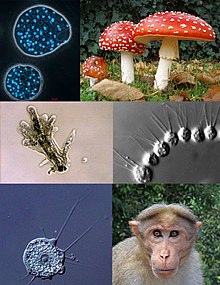Our website is made possible by displaying online advertisements to our visitors.
Please consider supporting us by disabling your ad blocker.
Obazoa
| Obazoa | |
|---|---|
 | |
| Intervallo geologico | |
| Classificazione scientifica | |
| Dominio | Eukaryota |
| (sottodominio) | Unikonta o Amorphea (Cavalier-Smith) Adl 2005 |
| (supergruppo) | Obazoa (Brown et al., 2013)[1] |
Gruppi | |
Obazoa (Brown et al., 2013)[1] è un proposto supergruppo, fratello di Amoebozoa (che insieme formano Amorphea). Obazoa è composto dai gruppi Breviatea, Apusomonadida e Opisthokonta. Il termine Obazoa si basa sull'acronimo OBA di O pisthokonta, B reviatea e A pusomonadida.[1] Determinare la collocazione di Breviatea e Apusomonadida e le loro proprietà è di interesse per lo sviluppo degli opistokonti in cui sono emerse le principali linee di animali e funghi.[1] Le relazioni tra opisthokonta, breviatea e apusomonada non sono risolte in modo definitivo (a partire dal 2018), sebbene Breviatea sia solitamente dedotta come il più basale dei tre lignaggi.[2][3][4][5][6]
- ^ a b c d (EN) Matthew W. Brown, Susan C. Sharpe, Jeffrey D. Silberman, Aaron A. Heiss, B. Franz Lang, Alastair G. B. Simpson e Andrew J. Roger, Phylogenomics demonstrates that breviate flagellates are related to opisthokonts and apusomonads, in Proceedings of the Royal Society of London B: Biological Sciences, vol. 280, n. 1769, 22 ottobre 2013, pp. 20131755, DOI:10.1098/rspb.2013.1755, ISSN 0962-8452, PMC 3768317, PMID 23986111.
- ^ (EN) Laura Eme, Susan C. Sharpe, Matthew W. Brown e Andrew J. Roger, On the Age of Eukaryotes: Evaluating Evidence from Fossils and Molecular Clocks, in Cold Spring Harbor Perspectives in Biology, vol. 6, n. 8, 2014, pp. a016139, DOI:10.1101/cshperspect.a016139, ISSN 1943-0264, PMC 4107988, PMID 25085908.
- ^ Michael A. Ruggiero, Dennis P. Gordon, Thomas M. Orrell, Nicolas Bailly, Thierry Bourgoin, Richard C. Brusca, Thomas Cavalier-Smith, Michael D. Guiry e Paul M. Kirk, Correction: A Higher Level Classification of All Living Organisms, in PLOS ONE, vol. 10, n. 6, 11 giugno 2015, pp. e0130114, Bibcode:2015PLoSO..1030114R, DOI:10.1371/journal.pone.0130114, ISSN 1932-6203, PMC 5159126, PMID 26068874.
- ^ Thomas Cavalier-Smith, Anna Maria Fiore-Donno, Ema Chao, Alexander Kudryavtsev, Cédric Berney, Elizabeth A. Snell e Rhodri Lewis, Multigene phylogeny resolves deep branching of Amoebozoa, in Molecular Phylogenetics and Evolution, vol. 83, 1º febbraio 2015, pp. 293–304, DOI:10.1016/j.ympev.2014.08.011, PMID 25150787.
- ^ Cavalier-Smith T, Megaphylogeny, cell body plans, adaptive zones: causes and timing of eukaryote basal radiations, in J. Eukaryot.Microbiol., vol. 56, n. 1, 2009, pp. 26–33, DOI:10.1111/j.1550-7408.2008.00373.x, PMID 19340985.
- ^ (EN) Matthew W Brown, Aaron A Heiss, Ryoma Kamikawa, Yuji Inagaki, Akinori Yabuki, Alexander K Tice, Takashi Shiratori, Ken-Ichiro Ishida e Tetsuo Hashimoto, Phylogenomics Places Orphan Protistan Lineages in a Novel Eukaryotic Super-Group, in Genome Biology and Evolution, vol. 10, n. 2, 19 gennaio 2018, pp. 427–433, DOI:10.1093/gbe/evy014, PMC 5793813, PMID 29360967.
Previous Page Next Page



